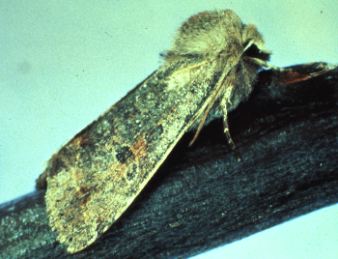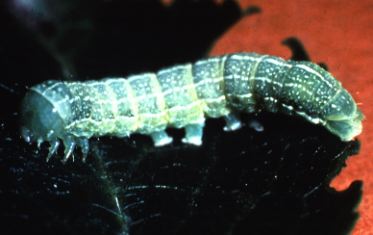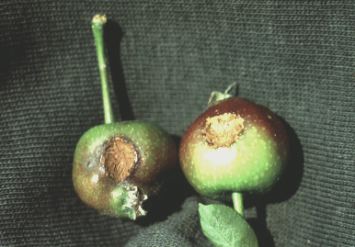 Green
Fruitworms,
Lithophane antennata (Walker), Orthosia hibisci
(Guenee) and
Green
Fruitworms,
Lithophane antennata (Walker), Orthosia hibisci
(Guenee) and
Amphipyra pyramidoides Guenee
I. Introduction: There are several species
of
fruitworms affecting apple; the green fruitworm,
L. antennata, speckled green fruitworm (O. hibisci) and
humped
green fruitworm (A. pyramidoides) are
among the more important. The speckled green fruitworm is the most
common.
II. Hosts: A wide host range, including apple, cherry,
plum,
pear, apricot, strawberry, quince,
willow, birch, poplar, balsam, alder, choke cherry, and maple.
When
densities peak generally, populations
overflow into orchards.
III. Description: Adults of most species are brownish moths
with
a wing spread of ca. 1.5 inch
(40 mm) (Plate 29). Larvae of the speckled green fruitworm are
light
green, while the humped green fruitworm
is darker green; both possess a pair of lateral white stripes,
with
additional white spots (Plate 30).
Additionally, the humped species has a dorsal hump at the rear of
the
body. Mature larvae are ca. 1.5 inch
(40 mm) long. Pupae resemble those of leafrollers, but are larger,
reaching lengths of about 3/4 inch (20 mm).
IV. Biology: Fruitworm species have one generation per
year.
Speckled green fruitworm overwinters
as pupae in the soil, adults emerging in the early spring and
invading
orchards and ovipositing at the onset
of tissue growth. Eggs are laid beginning at the half-inch-green
stage.
Humped green fruitworm overwinters
as an egg. These eggs hatch with other fruitworm species' eggs.
Larvae
feed on leaves, buds and developing
fruit; each larva may injure several fruit. When larvae are
mature,
they enter the soil to pupate. Adults
emerge in mid-summer, fall, or the following spring, according to
species.


V. Injury: Foliar injury is usually not important; economic
damage results from larvae feeding on
young fruit. Damaged fruit may drop early; or fruit may remain at
harvest with deeply sunken areas (Plate 31).
Symmetrical deep round holes are often seen resulting from green
fruitworm feeding. Injury may be confused
with that caused by early redbanded leafroller feeding, but is
usually
deeper.
VI. Monitoring: Examine 10 fruit per tree from each tree
scouted
from pink through early summer.
Beating trays have also been used to search for larvae. A
commercial
pheromone is available for speckled
green fruitworm (O. hibisci) that is very effective. A
provisional threshold of 1 larva or feeding scar
per tree has been used in Massachusetts.
This is taken primarily from a chapter by L.
A.
Hull, D. G. Pfeiffer & D. J. Biddinger on apple direct pests,
reprinted with permission from Mid-Atlantic Orchard Monitoring
Guide,
published
by
NRAES, 152 Riley-Robb Hall, Ithaca, New York 14853-5701.
Back to Virginia
Apple
Page
Back to Home Page for "Arthropod Management
in
Fruit Crops" course
Back to Virginia
Fruit
Page
 Green
Fruitworms,
Lithophane antennata (Walker), Orthosia hibisci
(Guenee) and
Green
Fruitworms,
Lithophane antennata (Walker), Orthosia hibisci
(Guenee) and
